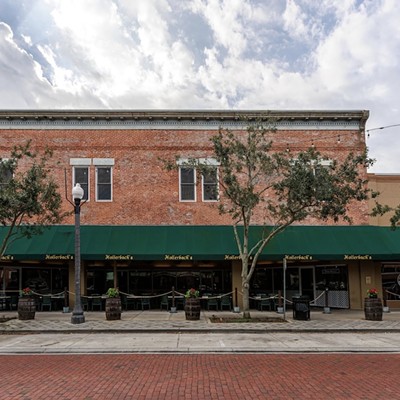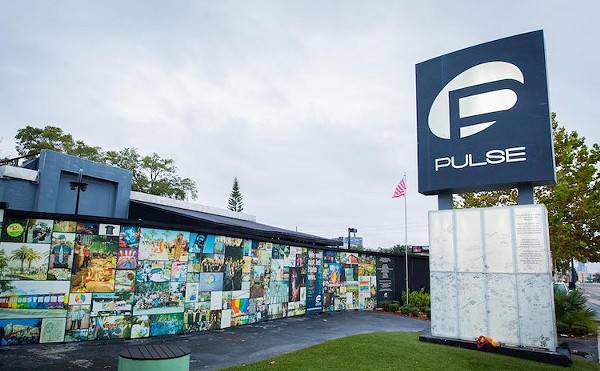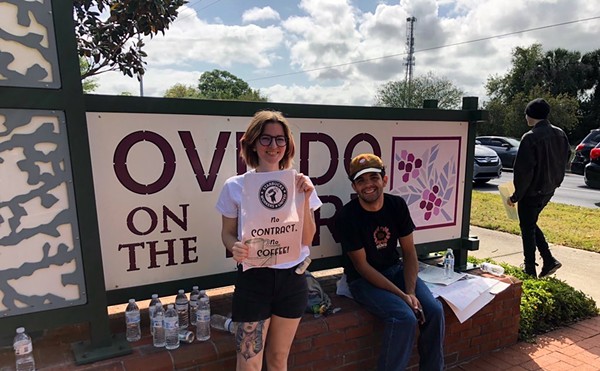Body piercing is an art without accountability. But that is about to change. ;;Tommy Dycus gleaned his earliest body-art lessons "mainly piercing myself and my buddies" with veterinary needles purchased at a feed-supply store in Sarasota. "That was pretty much guesswork then," fondly recalls Dycus, whose body is now adorned with a variety of rings, rods and spikes protruding from 26 piercings in places ranging from his ears to his scrotum.;;A decade later, Dycus, 29, has parlayed his affinity for sharp objects and willingness to compile fragments of knowledge about body piercing into a job as the house body artist at the Freak Shoppe in downtown Orlando.;;Boasting a year of professional experience and an informal;apprenticeship with another artist, Dycus’ resume -- though limited by virtually any other profession’s standards -- is relatively impressive in this business. In fact, piercing salons are so desperate for able artists, they steal capable ones, like Dycus, from competitors.;;In less than a decade, body art has grown into a multimillion-dollar business, supporting not only piercing salons, but the artisans and factories that provide the endless varieties of plastic, stainless steel and precious-metal hardware hung from thousands of piercings made each year in American bodies, as well as the companies selling expensive autoclaves, ultrasonic contraptions, disinfectants and other equipment and supplies used by responsible piercers to prevent the spread of infectious diseases.;;"Body piercing doesn’t do anything for me," says Bret Ashman, owner of the Freak Shoppe. "But I don’t have any problem making money from the people it does.";;Some weekend nights, as many as 25 people get pierced at the Freak Shoppe, one of more than a dozen local establishments that offer the perforation of human flesh as at least part of its business. The venues range from clothing stores to tattoo parlors to beauty salons, the customers from old to young, lawyer to laborer. Prices range from less than $30 to nearly $100 per piercing. ;;Though essentially a surgical procedure, no formal training, certification or regulation is required of piercing artists under federal law, in Florida or in most other states. As a result, there is virtually no accountability, no one looking out for the interests of growing numbers of people having jewelry implanted in their bodies.;;There is a growing movement to change this. On June 30, the National Environmental Health Association approved a comprehensive code covering not only piercing, but tattooing and other forms of body art. Designed for uniform enactment by states across the country, the code, which was authored by Volusia County health official Paul R. Fell, would require the licensing and regulation of artists and businesses involved in all forms of body art, except ear piercing, as well as an expensive set of "universal precautions" designed to prevent perceived health hazards. Each artist would be required to pass a written test, demonstrate an understanding of accepted health standards and complete an approved apprenticeship before poking holes in people for profit.;;"Some cities were trying to address the issue," says Fell, an environmental specialist with the Volusia County Health Department. "Everyone was calling everyone else." The model marks the first national effort that takes an organized, scientific approach to the regulation of piercing in America. In its absence, government officials have employed a variety of approaches based on emotion and politics as much as research or reason.;;In the past two years in Florida, piercing bills prepared by the state Department of Health have been passed by the House of Representatives. But both bills stalled in the Senate, where even the 1997 sponsor admits to relative indifference. Nationally, advocates say, body-piercing regulations are in place only in the states of Oregon and Wisconsin, and in a health district encompassing the city of Las Vegas.;;After four years of political wrangling, multiple changes and a veto by Gov. Pete Wilson, California appears ready to embrace limited regulation. In 1994, that state’s legislature passed a law that called for yearly inspections and basic health standards for all forms of body art, while establishing a task force to study the need for licensing and further regulation. But the Department of Health -- the agency expected to prepare the rules -- raised objections, citing skepticism at the lack of cases of body art leading to the transmission of infectious diseases. During the 1995-96 session, a similar bill never made it out of committee. Last month, another new bill was amended to a require a statewide group of county public-health officials, rather than the Department of Health, to set the standards. And another piece of legislation requiring parental consent for the piercing of anyone under 18 years old has been attached. Finally, Wilson is expected to sign on.;;In the absence of state law or direction from health authorities, officials in Florida cities have begun taking matters into their own hands. On June 11, Daytona Beach Shores began a six-month moratorium on body piercing, effectively shutting down businesses and prohibiting the opening of new shops, while awaiting direction from state legislators. A week earlier -- even as Fell was drafting the proposed national standard in his Daytona Beach office -- the Daytona Beach City Council enacted an ordinance prohibiting the piercing of anyone under 18 without parental consent, while giving little or no attention to health issues that are the clear focus of Fell’s proposal. Yet, while proposing a more comprehensive approach, Fell and other advocates welcome any effort to curb the hazard in Daytona Beach, "one of the scariest places in the country to get pierced," according to Michaela Grey, past chairman of the Association of Professional Piercers.;;But most Florida governments have yet to develop rules piercing popular myths. Orange County and the city of Orlando require only that piercing shops be licensed as businesses and properly dispose of used needles, while lacking the manpower to ensure growing numbers of piercers are adhering to even these limited standards.;;At the forefront of efforts to standardize regulations is the Association of Professional Piercers, a new trade organization that recently held a national meeting in Orlando. "Governments seem to be reluctant to be perceived as supporting the practice of piercing," says Grey, a piercer herself and one of a small number of artists trained in seminars and an apprenticeship program established by Gauntlet International, a global chain of piercing salons. "We see the possibility of an epidemic if something’s not done quickly." But the San Francisco-based trade group lists only one Florida member. It is so new that the proprietor of one of Orlando’s most popular body-art shops was unaware of the trade organization’s existence until a month ago.;;Health officials, recognizing the potential for transmission of blood-borne diseases, including hepatitis B, have been clamoring for regulation. Horror stories abound of ghastly infections and piercings so poorly done that the victims were unable to remove jewelry from an inflamed opening. The federal Centers for Disease Control and Prevention warn of the danger of transmitting HIV/AIDS. Meanwhile, virtually anyone with the nerve and the needles can pierce people for money.;;"You can get pierced at a fruit stand in New York," says Grey. "A lot of them give you a pager number. They meet you at the Taco Bell and pierce you on the toilet." Grey is almost certainly driven partly by the need to counter calls for an outright ban from groups such as the South Carolina AIDS Education Network.;;Yet skeptics, including California Gov. Wilson and Florida Sen. W.D. Childers, sponsor of the 1997 piercing bill in the state Senate, have suggested that such health hazards are overstated. "I don’t know about the spread of AIDS," says Childers. "I think you can pick that up a lot of places." Asked to elaborate, Childers said that people who shake hands with someone with lesions on their hands are at greater risk than anyone getting pierced.;;In fact, Florida health officials are unable to cite a single case of a blood-borne disease being transferred through body piercing, and only a handful of cases involving tattoos. But Amy Jones, general counsel for the Department of Health, says this can be partially explained by the lack of a regulation, or at least a standard process, for reporting of blood-borne diseases. Also, she points out, it is difficult to pinpoint piercing as the root cause of disease when pierced persons may have "made other lifestyle choices," leaving them more susceptible than the public at large to diseases such as AIDS, hepatitis B and syphilis. Certainly, more and more people are choosing to get pierced.;;For centuries various forms of body art have been part of tribal ritual and customs. Body piercing began to gain popularity in America in the 1970s, first with the gay leather S&M scene in San Francisco. But not until the 1990s did it gain acceptance in the mainstream, which previously pierced only its earlobes. ;;Four years ago, Alicia Silverstone, a co-star of the latest Batman movie, had her navel pierced for the "Cryin’" music video by Aerosmith. Lately in Orlando, navel piercings are the rage. "All the tourist girls, all the college girls, come in for a navel," says Freak Shoppe piercing artist Dycus. ;;Disciples of the Modern Primitive Movement see piercing as a path to heightened spirituality. Others choose body jewelry to make a rebellious statement. For still others, the jewelry heightens sexual pleasure. "It’s hard. It’s cold. It’s exotic. It’s sensual," says Theresa Anderson, vice president of Unity, an alternative clothing and accessories store on Colonial Drive.;; Body art even hangs on city safety officers. Nathan Tuten, the piercing artist at Unity, says he has placed jewelry in the nipples of Orlando police and firefighters. Probably the most successful salon in Orlando, Unity’s artists pierced about 7,000 people in the past year, Anderson says. Customers lay down $26 to $85, depending on the location of the pierce and the jewelry placed in it. "Body piercing is one of our most important departments," she says.;;Although unaware during a May interview that the Association of Professional Piercers existed, Anderson already has instituted at Unity many of the health standards supported by the association and health officials. Recently, the store copyrighted a pamphlet of instructions for care during the healing process. She advocates regulation for both health and business reasons. "People are being hurt by people who don’t know what they’re doing," she says. "Some of those smaller shops will [have to] shut down. That will bring more business for the more-established shops.";;In business only three months in the heart of the downtown entertainment district, Alan Dixon, owner of Alan’s Tattoo and Piercing Studio, is already expanding to a second location on tourist-dominated International Drive. The downtown shop is so busy, artist Jennifer Tuck said, "When I walked in after my job interview, I went right to work.";;As at Unity, Alan’s artists do both piercings and tattoos. And tattoos are the primary business of at least a dozen other shops in the area. But almost as many clothing stores, beauty shops and boutiques also pierce customers with little or no oversight.;;North of downtown in Fern Park is Tattoo Time, run by "Sailor Bill" Johnson, president of the Florida Professional Tattoo Artists Guild. A pool table and a wall of tattoos decorate the wood-paneled storefront, while several classic motorcycles are parked in the back. The ambience is quite different from the trendy decor and merchandise on display at piercing salons.;;For 18 years, Johnson has been doing tattoos. When asked, he will do piercings. "I could quit piercing. It wouldn’t bother me a bit," he says. "My primary business is tattooing. I don’t want to become a piercing establishment.’’;;Current state law only requires tattooists to work under the guidance of licensed medical practitioners -- doctors or dentists -- who are supposed to conduct periodic inspections. Though minimal, these are the state’s most stringent safeguards regarding body art.;;Last year, the tattoo artists guild engaged in some anxious lobbying against a Florida bill proposed by Rep. Carlos Valdes, which would have regulated piercing as well as tattooing and other forms of body art. Johnson and his membership eventually helped to see that the Valdes bill never came to a vote on the Senate floor -- and that this year’s follow-up bill excluded tattooists. Johnson said he was unable to convince the sponsor to amend the bill to require a professional test. "Valdes didn’t want anything to do with us," Johnson said.;;Recognizing the potential threats to their livelihood, tattooists now plan to lobby next year for a law setting health standards and requiring tattooists to pass a test written by tattoo-guild members. ;;Valdes traces his interest in the issue to a 1995 radio promotion inviting listeners to come to a Miami dance club for free piercings. Since then, he has participated in workshops with health officials and the Florida Medical Association before sponsoring the House bill in 1996 and 1997. The legislation, so far unsuccessful, requires no licensing or professional testing of individual piercers. But it does require that piercing businesses be licensed and inspected; that customers be at least 18 years old or prove parental consent; and imposes some of the precautions advocated by health authorities. (Although potentially more hazardous due to difficulties in sterilizing the "guns" commonly used in locations such as shopping mall kiosks, ear piercing would be exempt.) ;;"We regulate hair-braiding in Florida," Valdes says by way of comparison. "This is an invasive procedure. The bill will protect the public from the spread of infectious diseases. We have no idea who’s doing it or where it’s been done." He accuses Johnson and the tattoo lobby of being obstructionists, proposing last-minute changes that slowed the process.;;And while aware of similar risks from tattooing and other body art procedures, Valdes says he is satisfied for now just taking action against piercing: "We will always be able to make things better." He wonders what has kept the Senate -- for two years running -- from voting to follow the House. That, plus the governor’s signature, would make the piercing regulations the law in Florida.;;W.D. Childers is known as the dean of the Florida Senate. And as a senior member, he knows which bills are proposed by powerful lobbies and deep-pocketed special interests. Understandably he must set priorities, even among those bills -- including the companion to Valdes’ piercing legislation -- that he himself has sponsored. "If you put it up on a scale of priority, it doesn’t go up very high," Childers says. Asked why he never brought the bill to a floor vote, he offers only, "That happens a lot." But he is not wholly uninterested, and says he plans to refile the bill again next year.;;"It doesn’t have the priority of the good-old boys. It doesn’t have much economic impact. It’s unfortunate the health and safety of Florida citizens doesn’t rate any higher," says Bink Williams, a body artist in Tallahassee who monitors legislative efforts for the Association of Professional Piercers. And, while he believes the proposed law is lacking, "it would be so much better than nothing," he says.;;Meanwhile, Dycus keeps on piercing -- and getting pierced. On a recent afternoon, he coaxed a customer from a business next door to submit for a photo shoot. "I had a dream that my tongue was getting pierced," says Zon Carvalho, a website designer and the willing participant. "It will help me with the ladies.";;First, Carvalho is instructed to gargle for 10 seconds with mouthwash while sitting in a dentist’s chair. Then Dycus dons surgical gloves and quickly clamps Carvalho’s tongue, deadening it of sensation and purging it of blood. After marking his entry point, Dycus pushes through a hypodermic needle, followed by a piece of jewelry used to expel the needle from the bottom of Carvalho’s tongue. In about a minute, Carvalho is up and admiring his piercing in the mirror, relatively free of pain. "The only part I feel is the bottom of the tongue," he says. Before sending him back to work, Dycus advises him to abstain from drinking, smoking, eating and other oral activities. But then he advises his customer that he has broken every one of his own rules.;;Soon Dycus plans to get a "Prince Albert," a penis piercing named after an English prince who supposedly tied his penis to his leg so as not to betray any signs of arousal when before the queen. He is excited at the prospect that it will add to his and his girlfriend’s sexual pleasure -- while apparently undeterred by the hazards. After all, there’s no law against it.;;
Point of order
;;Guidelines offered by the Association of Professional Piercers:;;Every person being pierced has the right:;;To be pierced in a scrupulously hygienic, open environment, by a clean, conscientious piercer wearing a fresh pair of disposable latex gloves.;;To a sober, friendly, calm, and knowledgeable piercer, who will guide them through their piercing experience with confidence and assurance.;;To the peace of mind which comes from knowing that their piercer knows and practices the very highest standards of sterilization and hygiene.;;To be pierced with a brand-new, completely sterilized needle, which is immediately disposed of in a medical sharps container after use on the piercee alone.;;To be touched only with freshly sterilized, appropriate implements, properly used and disposed of or resterilized in an autoclave prior to use on anyone else.;;To know that ear-piercing guns are NEVER appropriate, and are often dangerous, when used on anything other than ear lobes.;;To be fitted only with jewelry which is appropriately sized, safe in material, design, and construction, and which best promotes healing. Gold-plated, gold-filled, and sterling silver jewelry are never appropriate for any new or unhealed piercing. ;;To be fully informed about proper aftercare, and to have continuing access to their piercer for consultation and assistance.

















